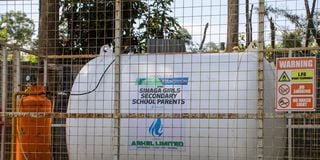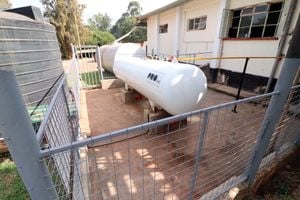Siaya schools adopt clean cooking energy

An LPG cylinder at Sinaga Girls High school in Gem Sub-county.
What you need to know:
- For three years now, Sinaga Girls High in Gem Sub-county has been using LPG as a primary source of energy for making meals for the 901 learners in the institution.
The near 100 per cent transition from primary school to secondary school has significantly increased the number of learners in learning institutions. This surge is particularly evident in secondary schools that accommodate thousands of learners
Most of these institutions rely heavily on wood fuel as their primary source of energy for cooking. This dependence has led to extensive tree cutting, further depleting the country's already limited forest cover.
But some schools in Siaya County have taken bold steps and switched from wood fuel to Liquefied Petroleum Gas (LPG), reducing their carbon pollution.
For three years now, Sinaga Girls High in Gem Sub-county has been using LPG as a primary source of energy for making meals for the 901 learners in the institution.
The 2,500-litre LPG cylinder has been serving the institution efficiently since 2021 and has improved sanitation of the kitchen, which initially was covered with thick layers of soot, according to deputy principal Jane Nyabera.
“Since installation, the LPG has served the institution well. To start with, unlike the times we used wood fuel, our kitchen and meals are clean,” says Ms Nyabera.
Efficiency
LPG has also improved time management and efficiency in food preparation.
To ensure that the students got their breakfast at 6am, the kitchen staff used to begin preparing it by 2am, which is not the case anymore.
“Initially, depending on the type of wood that we acquired, the meals would take long to prepare. Sometimes we would get wet trunks that took time to light, and preparing the meals was stressful. But now the meals get ready on time,” she adds.
“Occasionally when the wood got rained on, using them to prepare meals was a nightmare. But with LPG, the kitchen staff have an easy time preparing the meals,” she notes.
The deputy principal adds that frequent illnesses among the kitchen staff have also reduced. “The soot from wood that they inhaled often gave them health complications.”
To acquire the LPG cylinder, the institution collaborated with the Kenya Commercial Bank (KCB), which paid a percentage of the amount required, the rest being settled in installments.
Previously, the head of the kitchen staff, Christine Odhiambo, used to buy 12 to 15 tracks of firewood for cooking every term.
“For efficiency, we used trunks to cook, and that meant many trees would be cut down,” says Ms Odhiambo.
“At any given moment, when you walked into the kitchen, you would find a cloud of smoke in the entire room. Today, however, everyone is happy as we no longer cough like we did before the installation of the LPG cylinder.”
St Pius Got Matar Mixed Secondary School in Bondo Sub-county also successfully installed an LPG cylinder for their daily cooking.

An LPG cylinder at Got Matar Mixed Secondary in Bondo Sub-county.
Mr Gregory Ochieng, a teacher and a former student of the institution, compared the different times and gave a glowing review to the LPG.
“I can confidently state that when I was a student and now that I am a teacher in the same institution, the difference is like day and night. Back then, we faced serious challenges with firewood. Occasionally, we would get our meals late and that would eat into the lesson time,” he states, urging institutions to consider installing the LPG.
“The food would smell like smoke. Sometimes it would undercook because the firewood would be rained on. But with LPG, the quality of food is unquestionable.”
Like their colleague kitchen staff at Sinaga Girls, workers would complain of chest pains and eye problems brought by soot from firewood.
“This is clean energy that not only conserves our forest cover but also improves the health of the kitchen staff in our institutions,” adds Mr Ochieng.
St Pius Got Matar would utilise 12 pickups of firewood every term, according to the head kitchen staff Nicholas Otieno.
“As kitchen staff, we now enjoy our work compared to the days when we depended on firewood. With LPG, we can get enough time to rest as we wait to cook the next meal as opposed to when we used firewood.
“The ambience of our kitchen has also changed. It used to be very hot when we used firewood. Today, it’s relatively cool and clean.”
Like Sinaga Girls, St Pius Got Matar also acquired their LPG cylinder with the help of KCB Foundation that paid a fraction of the total cost while the remainder is paid through installments.
Mr Ibrahim Oyoo, a teacher based in Nakuru County and an environmental enthusiast, says: “All institutions should start investing in LPG because other than being efficient, it helps in conserving trees. Imagine the trees that will be saved if all institutions shift to LPG,” said Mr Oyoo.
As a way of replacing the trees that have been cut down, he challenges all institutions to set aside areas for planting trees within their compounds.
“With the Competency Based Curriculum encouraging the doing rather than theory, schools should give learners an opportunity to practise environmental conservation by planting trees,” he noted.





